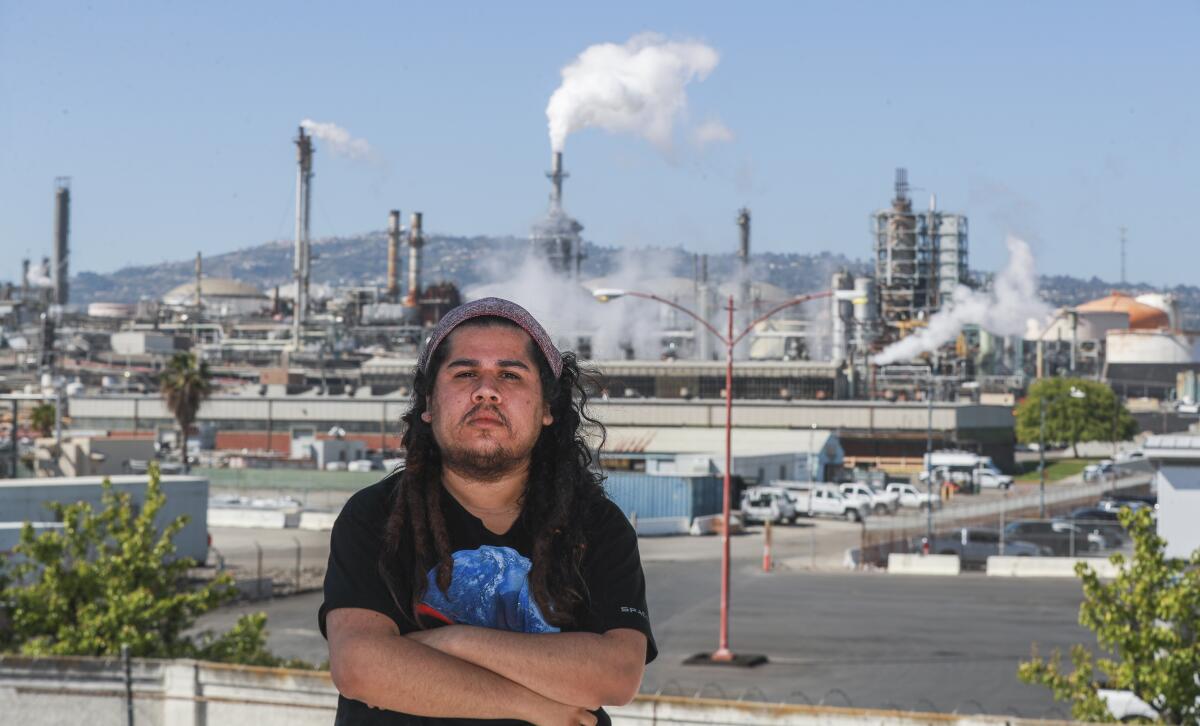Is California’s cap-and-trade program hurting the environment more than helping it?

- Share via
The breathing problems began when Ulises Flores was 13 years old.
Air struggled to pass through his nose, and he suffered frequent headaches. A doctor said his nostrils and sinuses were swollen, probably because of air pollution at his home in Wilmington, which hugs the fence line of the Phillips 66 oil refinery.
Growing up, Flores realized he wasn’t alone: Neighbors in his community that is 87% Latino were being diagnosed with asthma, others with cancer. Many children would get nosebleeds, and strange odors would fill the air.
“The most basic thing in this human life is clean air — we can’t even get that,” said 23-year-old Flores as he watched columns of steam rise from the refinery’s towers.
Since about the time Flores began experiencing breathing problems, the state of California has relied on a complicated market system of pollution credits to help reduce climate-warming greenhouse gas emissions. The program, called cap and trade, was the first of its kind in the U.S. when launched in 2013 and set the ambitious goal of slashing turn-of-the-century emission levels by 40% by the year 2030.
But despite its goal of reducing the gases that contribute to rising sea levels, extreme heat and record-shattering wildfires, the program was quickly faulted by environmental justice advocates for failing to improve the lives of low-income people of color living alongside major polluting facilities.
Now, after years of such criticism, government officials are reevaluating the program. In addition to environmental justice concerns, analysts have warned that the cap on how much companies can pollute “is likely not having much, if any, effect on overall emissions in the first several years of the program.”

Gov. Gavin Newsom’s office and state officials say they are in the middle of preparing an assessment of California’s various climate change programs. The results of this so-called scoping plan are expected to be released at the end of 2022. Officials have signaled that changes to the cap-and-trade program and how much the state relies on it are on the table.
“The scoping plan may show that as a proportion of total reductions, the cap and trade does not need to play such a major role in our toolbox going forward,” said Jared Blumenthal, secretary of the state’s Environmental Protection Agency, during a state Senate hearing last month.
As it operates now, the program sets a limit on how much companies can pollute and gives them the option to buy or trade credits. If a company wants to emit more greenhouse gases than they are allotted, they must buy allowance credits from the state during an auction. The proceeds from these auctions — which last year generated more than $2 billion — go toward other climate projects.
The state’s review follows criticisms that cap and trade includes a faulty offset program and an excess of allowances that critics say are too cheap. That allows companies to essentially buy their way out of lowering emissions, they say.
“They’ve literally saved more allowances than the cuts they’re expected to make,” said Danny Cullenward, a lawyer and energy economist who helped draft a committee report on the program. “So the worst case scenario is that they [polluting companies] don’t have to change very much; in fact, they might not have to change anything at all.”
Each allowance credit lets companies emit one metric ton of carbon dioxide, one of the main greenhouse gases. That’s about the same level of pollution emitted from one car driving 2,500 miles, about the distance from Los Angeles to Orlando, Fla.
However, the report found that these companies have bought and saved 321 million of these allowances that let them pollute, which could make it difficult for the state to force these companies to lower their emissions to meet the state’s 2030 goals.
Although Cullenward has called the number of saved allowances a “big warning sign,” California’s Air Resources Board and the Newsom administration say they need time to collect more data before deciding whether the allowance issue is worth addressing. Adjustments to the program may not come until 2024, they say.
Environmental justice advocates say those who pay the most immediate price for program shortcomings are those who live near major emitters.
One recent study published by the University of Southern California found that while the level of greenhouse gas emissions in the state have gone down since the cap-and-trade program went into effect, Black and Latino communities and other communities of color are still more exposed to pollution from facilities such as oil refineries when compared to white communities. A separate study by the state’s Office of Environmental Health Hazard Assessment came to similar conclusions.
The USC study also found that communities whose residents are predominantly people of color and are below federal poverty levels and less educated are less likely to see improvements in the level of emissions from facilities such as oil refineries. Such facilities release co-pollutants, such as nitrogen oxide, which can cause respiratory infections and asthma.
Some of those communities even saw the level of emissions grow worse since the start of the cap-and-trade program. Refinery communities that were whiter and wealthier, on the other hand, saw greater improvements.
“It doesn’t make too much of a difference where greenhouse gases are reduced — they tend to have a global impact that improves the situation for a lot of people,” said Manuel Pastor, a sociology professor at USC and lead author of the recent study. “But it makes a lot of difference with the co-pollutants that come with it — the particulate matter. For those reasons, it matters that this study and the OEHHA study show the distribution of these facilities is more tightly associated with race.”
For residents living alongside refineries, complex programs such as cap and trade boil down to a single concern: When and how will the quality of our lives improve?
Michelle Muñoz, 27, and her mother, Maria Muñoz, stood on the front porch of their family’s Wilmington home, where Michelle Muñoz lives with her children, siblings and parents. They watched over Michelle’s two young children as they ran throughout their frontyard, at one point hanging from the yard’s metal gate like a jungle gym, letting out screams and laughter.
Through the home’s canopy of fruit trees and queen palms, the pair caught a view of the Phillips 66 refinery, its towering steel columns releasing pillowy masses of vapor.
Both of her kids, a 7-year-old son and 3-year-old daughter, were diagnosed with asthma as babies, Michelle Muñoz said. Her younger brother, who also lives with them, has suffered from frequent nosebleeds since they were kids.
The state and the harshest critics of cap and trade agree that more needs to be done to narrow the gap between communities such as Wilmington and those with cleaner air.
“It’s a lost opportunity that the co-benefits of greenhouse gas reductions don’t happen in those communities that are hosting facilities regulated by cap and trade,” said Rachel Morello-Frosch, a professor at UC Berkeley and author of the USC study.
Morello-Frosch is among those who suggest a more targeted approach that regulates facilities more directly. That approach could include creating no-trade zones or price incentives targeted at facilities that aren’t reducing emissions fast enough.
Residents like Flores and Muñoz are on board with the idea of greater regulation of emissions at their neighboring Phillips refinery, but the most ideal option for them is shutting down the refinery altogether, which they acknowledge is unlikely, given the amount of profit generated from the refinery, which churns out 139,000 gallons of oil per day.
“That would be a dream for them to close,” Maria Muñoz said.
More to Read
Sign up for Essential California
The most important California stories and recommendations in your inbox every morning.
You may occasionally receive promotional content from the Los Angeles Times.











